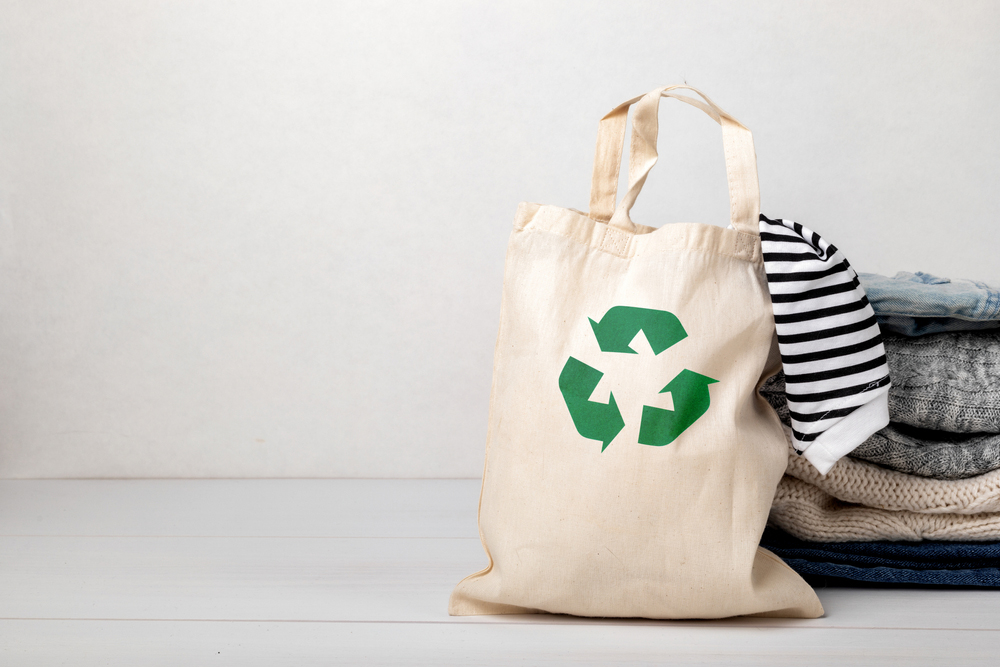
Second hand wardrobe idea. Circular fashion, eco friendly sustainable shopping, thrifting shop concept. Woman outfit.
A few years ago, you could position yourself as a sustainable fashion brand just by using organic cotton. Today the consumer expects much more. It’s about the carbon footprint of products and companies and achieving climate neutrality, or even better, climate positivity.
Achieving circularity in the textile sector is a lofty goal. Emphasis must be on reducing the use scarce resources, innovating in textile design, adopting new technologies and renewable materials, increasing the reuse and recycling of old garments and by eliminating waste and pollution.
Instead of manufacturing or buying new products, retailers, brands, and consumers are increasingly turning to alternative consumption models. The global second-hand fashion market has been growing and is forecast to total 34 billion euros by 2025. From The North Face and Vaude to H&M and Zalando, brands and retailers are investing in new resale business models and offering second-hand goods alongside their regular collections.
The same goes for fashion rental services. Recently, numerous retailers and brands have launched rental services covering areas from luxury fashion to skiwear. Like other areas of consumption, the desire to own fashion and textile garments is evolving with a growing trend towards rental.
Closing the loop for circularity across the global textile sector is a large leap closer thanks to sustained efforts by Datamars.
Datamars is increasing its sustainability contribution by expanding the power of its textile RFID identification and traceability technology to enable advancements on many fronts of Reduce, Reuse, Recycle. These advancements relate to the reduction of garments and virgin fibre needed in circulation through advanced inventory efficiency and more effective recycling, the reduction of wasteful use of water and electricity through precision industrial laundering processes, the re-use of garments with effective inventory and hygiene traceability, and effective recycling to enable second life.
On the topic of reducing waste, Riccardo Mazzolini, VP Textile ID says industrial laundries across Europe, North America and Asia are using Datamars RFID technologies to identify and track large volumes of individual garments across their operations, reducing handling and loss, optimising garment usage and providing data to better manage resources used during laundering such as water and electricity.
“Data gathered during laundry operations, such as the number of washes, timing or method of washing, is giving businesses the information to drive improvements in their responsible practices and make measurable differences to their business and the planet.”
“The same data is helping businesses make better use of their inventory through asset tracking. Greater knowledge about the textiles that they have in circulation allows them to reduce the amount of inventory purchased and have a more sustainable impact on the environment in general.”
“You’d be amazed at the number of items lost through a manual process and the requirements to purchase additional garments just to manage the inefficiencies. If there is better visibility and you know exactly where an item is at all times, you can manage better – with less,” says Riccardo.
On the topic of reuse, Riccardo says that when considering sustainability in the textile world, “the ideal goal is to optimise reusage”.
With this view, Datamars RFID technology is paving the way for a rising trend in high-end garment rentals, allowing the same item of clothing to be reused by multiple people. The new rental business model offers an ever-changing wardrobe at a much lower cost to the consumer, allows the garment to be reused more frequently, and is a big move in minimising the impact of fast fashion by reducing the number of garments produced that may have otherwise entered the waste stream. Datamars currently serves the market leader for this business model.
“All this is made possible and commercially viable thanks to the use of our highly durable RFID and a small UHF tag for a perfect fit within all garments. Datamars technology has helped fully automate the company’s internal processes, increased efficiencies and helped minimise costs so they can offer these garments at an acceptable price for their customers.”
“Already 1.2 million garments have been chipped, bringing the total of their circulating garments, covered by RFID, up to 75%. The goal is to achieve 100% by the year end.”
While RFID tags in clothing isn’t new in itself, Datamars is the only technology that is durable enough to withstand the harsh laundry environment, which makes it suitable to support a rental and reuse model, supporting the important aspects of hygiene and inventory management for rental garments.
“Beyond reuse, the recycling of textiles today is often a challenge, largely because recycling providers don’t know enough about the textile itself to be able to determine and develop suitable practices to recycle the material to the point where it can go back into the raw material phase again. For this reason, a lot of textile recycling is actually just garments turned into rags, which have limited use and it doesn’t help significantly reduce the amount of virgin fibre material created,” explains Riccardo.
Datamars RFID solutions allow apparel businesses to track garments into their second life. When an item is returned by the renters or purchasers, brands like H&M or Zara may use information about the garment to find out how to better recycle the item or track the second life of the item into what is going to be a growing second-hand market.
But the best is yet to come: Datamars, in its ever-increasing focus and commitment to maximise the positive impact it can have on its sectors, is preparing to launch new products and new value-added services that further support more sustainable production, commercial success and quality of life. Stay tuned!
Learn more about Datamars’ sustainability journey at datamars.com/sustainability.